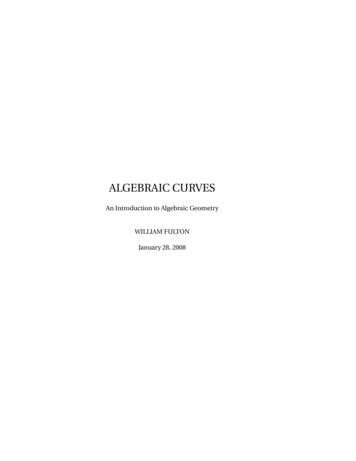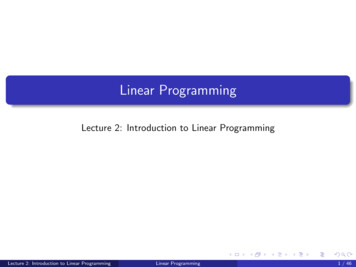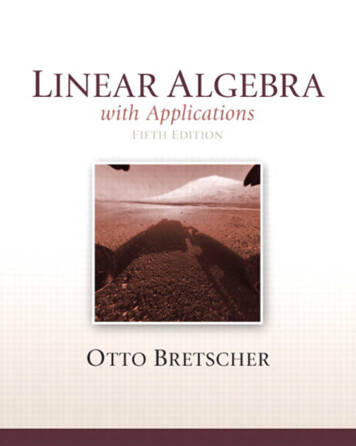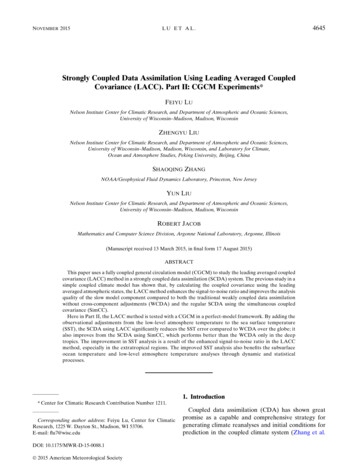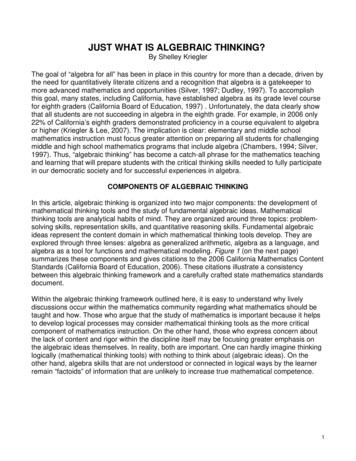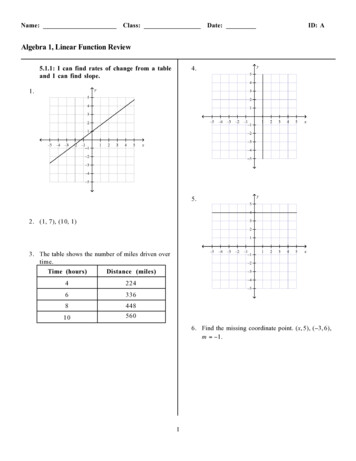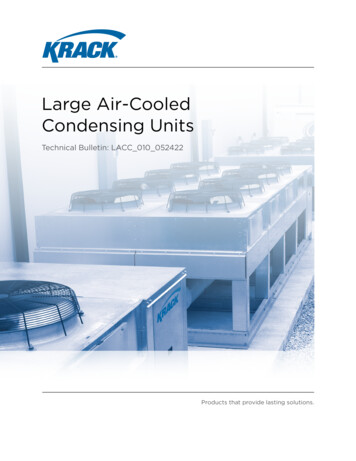
Transcription
LACC: A Linear-Algebraic Algorithm for FindingConnected Components in Distributed MemoryAriful AzadAydın BuluçDepartment of Intelligent Systems EngineeringIndiana University, Bloomingtonazad@iu.eduComputational Research DivisionLawrence Berkeley National Laboratoryabuluc@lbl.govAbstract—Finding connected components is one of the mostwidely used operations on a graph. Optimal serial algorithmsfor the problem have been known for half a century, and manycompeting parallel algorithms have been proposed over the lastseveral decades under various different models of parallel computation. This paper presents a parallel connected-componentsalgorithm that can run on distributed-memory computers. Ouralgorithm uses linear algebraic primitives and is based on aPRAM algorithm by Awerbuch and Shiloach. We show thatthe resulting algorithm, named LACC for Linear AlgebraicConnected Components, outperforms competitors by a factorof up to 12x for small to medium scale graphs. For largegraphs with more than 50B edges, LACC scales to 4K nodes(262K cores) of a Cray XC40 supercomputer and outperformsprevious algorithms by a significant margin. This remarkableperformance is accomplished by (1) exploiting sparsity that wasnot present in the original PRAM algorithm formulation, (2)using high-performance primitives of Combinatorial BLAS, and(3) identifying hot spots and optimizing them away by exploitingalgorithmic insights.I. I NTRODUCTIONGiven an undirected graph G (V, E) on the set of verticesV and the set of edges E, a connected component is asubgraph in which every vertex is connected to all othervertices in the subgraph by paths and no vertex in the subgraphis connected to any other vertex outside of the subgraph.Finding all connected components in a graph is a well studiedproblem in graph theory with applications in bioinformatics [1]and scientific computing [2], [3].Parallel algorithms for finding connected components alsohave a long history, with several ingenious techniques appliedto the problem. One of the most well-known parallel algorithms is due to Shiloach and Vishkin [4], where they introduced the hooking procedure. The algorithm also uses pointerjumping, a fundamental technique in PRAM (parallel randomaccess machine) algorithms, for shortcutting. Awerbuch andShiloach [5] later simplified and improved on this algorithm.Despite the fact that PRAM model is a poor fit for analyzingdistributed memory algorithms, we will show in this paperthat the Awerbuch-Shiloach (AS) algorithm admits a veryefficient parallelization using proper computational primitivesand sparse data structures.Decomposing the graph into its connected components isoften the first step in large-scale graph analytics where the goalis to create manageable independent subproblems. Therefore,it is important that connected component finding algorithmscan run on distributed memory, even if the subsequent stepsof the analysis need not. Several applications of distributedmemory connected component labeling have recently emergedin the field of genomics. The metagenome assembly algorithmsrepresent their partially assembled data as a graph [6], [7].Each component of this graph can be processed independently.Given that the scale of the metagenomic data that needs to beassembled is already on the order of several TBs, and is ontrack to grow exponentially, distributed connected componentalgorithms are of growing importance.Another application comes from large scale biological network clustering. The popular Markov clustering algorithm(MCL) [1] iteratively performs a series of sparse matrix manipulations to identify the clustering structure in a network. Afterthe iterations converge, the clusters are extracted by findingthe connected components on the symmetrized version of thefinal converged matrix, i.e., in an undirected graph representedby the converged matrix. We have recently developed thedistributed-memory parallel MCL (HipMCL) [8] algorithmthat can cluster protein similarity networks with hundredsof billions of edges using thousands of nodes on modernsupercomputers. Since computing connected components is animportant step in HipMCL, a parallel connected componentalgorithm that can scale to thousands of nodes is imperative.In this paper, we present a distributed-memory implementation of the AS algorithm [5]. We mapped the AS algorithmto GraphBLAS [9] primitives, which are standardized linearalgebraic functions that can be used to implement graph algorithms. Our algorithm is named as LACC for linear algebraicconnected components. While the initial reasons behind choosing the AS algorithm were simplicity, performance guarantees,and expressibility using linear algebraic primitives, we foundthat it is never slower than the state-of-the-art distributedmemory algorithm ParConnect [10], and it often outperformsParConnect by several fold.The actual implementation of our algorithm uses the Combinatorial BLAS (CombBLAS) library [11], a well-knownframework for implementing graph algorithms in the language of linear algebra. Different from the AS algorithm,our implementation fully exploits vector sparsity and avoidsprocessing on inactive vertices. We perform several additionaloptimizations to eliminate performance hot spots and provide a
detailed breakdown of our parallel performance, both in termsof theoretical communication complexity and in experimentalresults. These algorithmic insights and optimizations result ina distributed algorithm that scales to 4K nodes (262K cores)of a Cray XC40 supercomputer and outperforms previousalgorithms by a significant margin.Distributed-memory LACC code that is used in our experiments is publicly available as part of the CombBLAS library1 .A simplified unoptimized serial GraphBLAS implementationis also committed to the LAGraph Library2 for educationalpurposes.II. BACKGROUNDA. NotationsThis paper only considers an undirected and unweightedgraph G (V, E) with n vertices and m edges. Given avertex v, N (v) is the set of vertices adjacent to v. A tree isan undirected graph where any two vertices are connected byexactly one path. A directed rooted tree is a tree in which avertex is designated as the root and all vertices are orientedtoward the root. The level l(v) of a vertex v in a tree is 1 plusthe number of edges between v and the root. The level of theroot is 1. A tree is called a star if every vertex is a child ofthe root (the root is a child of itself). A vertex is called a starvertex is it belongs to a star.B. GraphBLASThe duality between sparse matrices and graphs has a longand fruitful history [12], [13]. Several independent systemshave emerged that use matrix algebra to perform graph operations [11], [14], [15]. Recently, the GraphBLAS forum defineda standard set of linear-algebraic operations for implementinggraph algorithms, leading to the GraphBLAS C API [16]. Inthis paper, we will use the functions from the GraphBLAS APIto describe our algorithms. That being said, our algorithmsrun on distributed memory while, currently no distributedmemory library faithfully implements the GraphBLAS API.The most recent version of the API (1.2.0) is actually silenton distributed-memory parallelism and data distribution. Consequently, while our descriptions follow the API, our implementation will be based on CombBLAS functions [11],which are either semantically equivalent in functionality totheir GraphBLAS counterparts or can be composed to matchGraphBLAS functionality.C. Related workFinding connected components of an undirected graph isone of the most well-studied problems in the PRAM (parallelrandom-access memory) model. A significant portion of thesealgorithms assume the CRCW (concurrent-read concurrentwrite model). We based our distributed-memory implementation on the Awerbuch-Shiloach (AS) algorithm, which itselfis a simplification of the Shiloach-Vishkin (SV) algorithm [4].1 as-2.0/2 https://github.com/GraphBLAS/LAGraphThe fundamental data structure in both AS and SV algorithmsis a forest of rooted trees. While AS only keeps the informationof the current forest, SV additionally keeps track of the forestin the previous iteration of the algorithm as well as thelast time each parent received a new child. The convergencecriterion for AS is to check whether each tree is a star whereasSV needs to see whether the last iteration provided any updatesto the forest. Due to its simpler data structures, AS is a bettercandidate for GraphBLAS-style implementation.Randomization is also a fundamental technique applied tothe connected components problem. The random-mate (RM)algorithm, due to Reif [17], flips an unbiased coin for eachvertex to determine whether it is a parent or a child. Eachchild then finds a parent among its neighbors. The stars arecontracted to supervertices in the next iteration as in ASand SV algorithms. All three algorithms described so far(RM, AS, and SV) are work inefficient in the sense thattheir processor-time product is asymptotically higher than theruntime complexity of the best serial algorithm.A similar randomization technique allowed Gazit to discover a work-efficient CRCW PRAM algorithm for the connected components problem [18]. His algorithm runs withO(m) optimal work and O(log(n)) span. More algorithmsfollowed achieving the same work-span bound but improvingthe state-of-the-art by working with more restrictive modelssuch as EREW (exclusive-read exclusive-write) [19], solvingmore general problems such as minimum spanning forest [20]whose output can be used to infer connectivity, and providingfirst implementations [21].The literature on distributed-memory connected componentalgorithms and their complexity analyses, is significantlysparser than the case for PRAM algorithms. The state-of-theart prior to our work is the ParConnect algorithm [10], whichis based on both the SV algorithm and parallel breadth-firstsearch (BFS). Slota et al. [22] developed a distributed memoryMultistep method that combines parallel BFS and label propagation technique. There have also been implementations ofconnected component algorithms in PGAS (partitioned globaladdress space) languages [23] in distributed memory. ViralShah’s PhD thesis [24] presents a data-parallel implementationof the AS algorithm that runs on Matlab*P, a distributedvariant of Matlab that is now defunct. Shah’s implementationuses vastly different primitives than our own and solely relieson manipulating dense vectors, hence is limited in scalability.Kiveras et al. [25] proposed the Two-Phase algorithm forMapReduce systems. Such algorithms tend to perform poorlyin tightly-couple parallel systems our work targets compared tothe loosely-coupled architectures that are optimized for cloudworkloads. There is also recent work on parallel graph connectivity within the theory community, using various differentmodels of computation [26], [27]. These last two algorithmsare not implemented and its is not clear if such complexalgorithms can be competitive in practice on real distributedmemory parallel systems.
012530246524561346(c) Conditional hooking of starsA starA nonstar053(b) Initially, every vertex is a star(a) A connected graph20113004265(d) Check for stars3516263144(f) Shortcutting(e) Unconditional hooking of starsFig. 1: An illustrative example of the the AS algorithm. Edges are shown in solid black edges. A dashed arrowhead connectsa child with its parent. (a) An undirected and unweighted graph. (b) Initially, every vertex forms a singleton tree. (c) Afterconditional hooking. Here, we only show edges connecting vertices from different trees. (d) Identifying vertices in stars (seeFigure 2 for details). (e) After unconditional hooking: the star rooted at vertex 1 is hooked onto the left tree rooted at vertex0. (f) After shortcutting, all vertices belong to stars. The algorithm returns with a connected component.10245136(a) initialize: everyvertex is in a star0245136(b) Mark all vertices exceptvertices at level 20245Belongs to a a star3Does not belong to a star6(c) Mark verticesat level 2Fig. 2: Finding star vertices. Star and nonstar vertices are shown with unfilled and filled circles, respectively. A dashed arrowheadconnects a child with its parent. (a) Initially, every vertex is assumed to be a star vertex. (b) Every vertex v with l(v) 2 andits grandparent are marked as nonstar vertices. (c) In a nonstar tree, vertices at level 2 are marked as nonstar vertices.III. T HE AWERBUCH -S HILOACH (AS) ALGORITHMOverview. The AS algorithm maintains a forest (a collectionof directed rooted trees), where each tree represents a connected component at the current stage of the algorithm. Thealgorithm begins with n single-vertex stars. In every iteration,the algorithm merges stars with other trees (both stars andnonstars) until no such merging is possible. This merging isperformed by a process called star hooking, where the root ofa star becomes a child of a vertex from another tree. Hookingstars unconditionally to other trees may create a cycle of trees,violating the forest requirement of the algorithm [5]. Hence,the algorithm performs a conditional hooking, followed by anunconditional hooking. Between two subsequent iterations, thealgorithm reduces the height of trees by a process called shortcutting, where a vertex becomes a child of its grandparent.The algorithm maintains a parent vector f , where f [v] storesthe parent of a vertex v. To track vertices in stars, the algorithmmaintains a Boolean vector star. For every vertex v, star[v]is true if v is a star vertex, star[v] is false otherwise.Description of the algorithm. Algorithm 1 describes themain components of the AS algorithm. Initially, every vertexis its own parent, creating n single-vertex stars (lines 2-3 ofAlgorithm 1). In every iteration, the algorithm performs threeoperations: (a) conditional hooking, (b) unconditional hookingand (c) shortcutting. In the conditional hooking (lines 6-8),every edge {u, v} is scanned to see if (a) u is in a star and(b) the parent of u is greater than the parent of v. If theseconditions are satisfied, f [u] is hooked to f [v] by makingthe latter to be the parent of the former. The remaining starsthen get a chance to hook unconditionally (lines 10-12). In theshortcutting step, the grandparent of all vertices are identifiedand stored in the gf vector (lines 14-15). The gf vector is thenused to update parents of all vertices (lines 16-18). Figure 1shows the execution of different steps of the AS algorithm.Algorithm 2 and Figure 2 describe how star vertices are
Algorithm 1 The skeleton of the AS algorithm. Inputs: anundirected graph G(V, E). Output: The parent vector f1: procedure AWERBUCH -S HILOACH(G(V, E))2:for every vertex v in V do3:f [v] rithm 2 Finding vertices in stars. Inputs: a graphG(V, E) and the parent vector f . Output: The star vector.1: procedure S TARCHECK(G(V, E), f )2:for every vertex v in V do in parallel3:star[v] true4:gf [v] f [f [v]]. Initializerepeat. Step1: Conditional star hookingfor every edge {u, v} in E do in parallelif u belongs to a star and f [u] f [v] thenf [f [u]] f [v]. Step2: Unconditional star hookingfor every edge {u, v} in E do in parallelif u belongs to a star and f [u] 6 f [v] thenf [f [u]] f [v]. Step3: Shortcuttingfor every vertex v in V do in parallelgf [v] f [f [v]]for every vertex v in V do in parallelif v does not belongs to a star thenf [v] gf [v]]until f remains unchangedreturn fidentified based on the parent vector. Initially, every vertex vis assumed to be a star vertex by setting star[v] to true (line3 of Algorithm 2). The algorithm marks vertices as nonstarsif any of the following three conditions is satisfied: v’s parent and grandparent are not the same vertex. Inthis case, l(v) 2 as shown in Figure 2(b) If v is a nonstar vertex, then its grandparent is also anonstar vertex (Figure 2(b) and and line 9 of Algorithm 2) If v’s parent is a nonstar, then v is also a nonstar vertex(Figure 2(c) and lines 11-12 of Algorithm 2)The AS algorithm terminates when every tree becomes a starand the parent vector f is not updated in the latest iteration.The algorithm terminates in O(log n) iterations. Hence, thealgorithm runs in O(log n) time using m n processors inthe PRAM model.IV. T HE AS ALGORITHM USING MATRIX ALGEBRAIn this section, we design the AS algorithm using theGraphBLAS API [9]. We used GraphBLAS API to describeour algorithms because the API is more expressive, wellthought-of, and future proof. Below we give an informaldescription of GraphBLAS functions used in our algorithms.Formal descriptions can be found in the API document [28].ThefunctionGrB Vector nvalsretrievesthenumber of stored elements (tuples) in a vector.GrB Vector extractTuples extracts the indices and valuesassociated with nonzero entries of a vector. In all otherGraphBLAS functions we use, the first parameter is theoutput, the second parameter is the mask that determinesto which elements of the output should the result ofthe computation be written into, and the third parameterdetermines the accumulation mode. We will refrain from usingan accumulator and instead be performing an assignment inall cases; hence our third parameter is always GrB NULL.5:6:7:8:9:10:11:12:13:. Initialize. Exclude every vertex v with l(v) 2 and its grandparentfor every vertex v in V do in parallelif f [v] 6 gf [v] thenstar[v] falsestar[gf [v]] false. In nonstar trees, exclude vertices at level 2for every vertex v in V do in parallelstar[v] star[f [v]]return starThe function GrB mxv multiplies a matrix with a vector ona semiring, outputting another vector. The GraphBLAS APIdoes not provide specialized function names for sparse vs.dense vectors and matrices, but instead allows the implementation to internally call different subroutines based on inputsparsity. In our use case, matrices are always sparse whereasvectors start out dense and get sparse rapidly. GrB mxvoperates on a user defined semiring object GrB Semiring.We refer to a semiring by listing its scalar operations,such as the (multiply, add) semiring. Our algorithm usesthe (Select2nd, min) semiring with the GrB mxv functionwhere Select2nd returns its second input and min returns theminimum of its two inputs. The vector variant of GrB extract extracts a sub-vectorfrom a larger vector. The larger vector from which we areextracting elements from is the fourth parameter. The fifthparameter is a pointer to the set of indices to be extracted,which also determines the size of the output vector. The vector variant of the GrB assign function that assignsthe entries of a GraphBLAS vector (u) to another, potentiallylarger, vector w. The vector whose entries we are assigningto is the fourth parameter u. The fifth parameter is a pointerto the set of indices of the output w to be assigned. The vector variant of GrB eWiseMult performs elementwise (general) multiplication on the intersection of elementsof two vectors. The multiplication operation is provided as aGrB Semiring object in the fourth parameter and the inputvectors are passed in the fifth and sixth parameters.We will refrain from making a general complexity analysis of these operations as the particular instantiations havedifferent complexity bounds. Instead, we will analyze theircomplexities as they are used in our particular algorithms. A. Designing the AS algorithm using GraphBLAS primitivesConditional hooking. Algorithm 3 describes the conditional hooking operation designed using the GraphBLAS API.For each star vertex v, we identify a neighbor with the minimum parent id. This operation is performed using GrB mxv inline 4 of Algorithm 3 where we multiply the adjacency matrixA by the parent vector f on the (Select2nd, min) semiring.
Algorithm 3 Conditional hooking of stars. Inputs: an adjacency matrix A, the parent vector f , the star-membershipvector star. Output: Updated f . (NULL is denoted by )1: procedure C OND H OOK(A, f , star )2:Sel2ndMin a (select2nd, min) semiring3:. Step1: fn [i] stores the parent (with the minimum id) of a4:5:6:7:8:9:10:11:12:neighbor of vertex i. Next, fn [i] is replaced by min{fn [i], f [i]}GrB mxv (fn , star , , Sel2ndMin, A, f , )GrB eWiseMult (fn , , , GrB MIN T, fn , f , );. Step2: Parents of hooks (hooks are nonzero indices in fn )GrB eWiseMult (fh , , , GrB SECOND T, fn , f , ). Step3: Hook stars on neighboring trees (f [fh ] fn ).GrB Vector nvals(&nhooks, fn )GrB Vector extractTuples (index, value, nhooks, fh )GrB extract (fn , , , fn , index, nhooks, ). DenseGrB assign (f , , , fn , value, nhooks, )Algorithm 4 Unconditional star hooking. Inputs: an adjacency matrix A, the parent vector f , the star-membershipvector star. Output: Updated f . (NULL is denoted by )1: procedure U NCOND H OOK(A, f , star )2:Sel2ndMin a (select2nd, min) semiring3:. Step1: For a star vertex, find a neighbor in a nonstar. fn [i]4:5:6:stores the parent (with the minimum id) of a neighbor of iGrB extract(fns , star , , f , GrB ALL, 0, GrB SCMP)GrB mxv (fn , star , , Sel2ndMin, A, fns , ). Step 2 and 3 are similar to Algorithm 3Algorithm 5 The shortcut operation. Input: the parent vectorf . Output: Updated f .1: procedure S HORTCUT(f )2:. find grandparents (gf f [f ])3:GrB Vector extractTuples(idx, value, &n, f )4:GrB extract (gf , , , f , value, n, )5:GrB assign (f , , , gf , GrB ALL, 0, ). n V . f gfWe only keep star vertices by using the star vector as a mask.The output of GrB mxv is stored in fn , where fn [v] storesthe minimum parent among all parents of N (v) such that vbelongs to a star. If the parent f [v] of vertex v is smaller thanfn [v], we store f [v] in fn [v] in line 5. Nonzero indices infn [v] are called hooks. Next, we identify parents fh of hooksin line 7 by using the GrB eWiseMult function that simplycopies parents from f based on nonzero indices in fn . Here,fh contains roots because only a root can be a parent within astar. In the final step (lines 9-12), we hook fh to fn by usingthe GrB assign function. In order to perform this hooking,we update parts of the parent vector f by using nonzero valuesfrom fh as indices and nonzero values from fn as values.Unconditional hooking. Algorithm 4 describes unconditional hooking. As we will show in Lemma 2, unconditionalhooking only allows a star to get hooked onto a nonstar.Hence, in line 4, we extract parents fns of nonstar vertices(GrB SCMP denotes structural complement of the mask),which is then used with GrB mxv in line 5. Here, we breakties using the (Select2nd, min) semiring, but we could haveused other semiring addition operations instead of “min”. Therest of Algorithm 4 is similar to Algorithm 3.Shortcut. Algorithm 5 describes the shortcutting operation using two GraphBLAS primitives. At first, we useGrB extract to obtain the grandparents gf of vertices. Next,we assign gf to the parent vector using GrB assign.Starcheck. Algorithm 6 identifies star vertices. At first,we initialize all vertices as stars (line 2). Next, we identifythe subset of vertices h whose parents and grandparents aredifferent (lines 4-5) using a Boolean mask vector hbool.Nonzero indices and values in h represent vertices and theirgrandparents, respectively. In lines 7-10, we mark these vertices and their grandparents as nonstars. Finally, we mark avertex nonstar if its parent is also a nonstar (lines 12-14).Implementing LACC using the SuiteSparse:GraphBLASlibrary. Currently, only the SuiteSparse:GraphBLAS library3provides a full sequential implementation of the GraphBLAS C API. We developed a simplified unoptimized serial GraphBLAS implementation of LACC using the SuiteSparse:GraphBLAS library to test the correctness of the presented algorithms with respect to the GraphBLAS API. OurSuiteSparse:GraphBLAS implementation is committed to theLAGraph Library4 for educational purposes. In this paper,we do not report any performance numbers from the SuiteSparse:GraphBLAS implementation because it lacks several keyoptimizations (e.g., use of sparsity) that we implemented inCombBLAS.B. Efficient use of sparsityAs shown in Algorithm 1, every iteration of the original ASalgorithm explores all vertices in the graph. Hence, conditionaland unconditional hooking explore all edges, and shortcut andstarcheck explore all entries in parent and star vectors. If wedirectly translate the AS algorithm to linear algebra, all ofour operations will use dense vectors, which is unnecessaryif some vertices remain “inactive” in an iteration. A keycontribution of this paper is to identify inactive vertices andsparsify vectors whenever possible so that we can eliminateunnecessary work performed by the algorithm. We now discussways to exploit sparsity in different steps of the algorithm.Tracking converged components. A connected componentis said to be converged if no new vertex is added to itin subsequent iterations. We can keep track of convergedcomponents using the following lemma.Lemma 1. Except in the first iteration, all remaining starsafter unconditional hooking are converged components.Proof. Consider a star S after the unconditional hooking in theith iteration where i 1. In order to hook S in any subsequentiteration, there must be an edge {u, v} such that u S andv / S. Let v belong to a tree T at the beginning of the ithiteration. If T is a star, then the edge {u, v} can be used tohook S onto T or T onto S depending on the labels of theirroots. If T is a nonstar, the edge {u, v} can be used to hook Sonto T in unconditional hooking. In any of these cases, S will3 http://faculty.cse.tamu.edu/davis/GraphBLAS.html4 https://github.com/GraphBLAS/LAGraph
Algorithm 6 Updating star memberships. Inputs: the parentvector f , the star vector star. Output: Updated star vector.1: procedure S TARCHECK(f , star )2:GrB assign (star , , , true, GrB ALL, 0, ) . initialize3:. vertices whose parents and grandparents are different. See4:5:6:7:8:9:10:11:12:13:14:Algorithm 5 for the code for computing grandparents gfGrB eWiseMult(hbool , , , GrB NE T, f , gf , )GrB extract(h , hbool , , gf , GrB ALL, 0, ). mark these vertices and their grandparents as nonstarsGrB Vector nvals(&nnz, h)GrB Vector extractTuples(index, value, nnz, h)GrB assign (star , , , false, index, nnz, )GrB assign (star , , , false, value, nnz, ). star[v] star [f [v]]GrB Vector extractTuples(idx, value, &n, f ) . n V GrB extract (starf , , , star, value, n, )GrB assign (star , , , starf , GrB All, 0, )TABLE I: The scope of using sparse vectors at different stepsof LACC (does not apply to the first iteration).OperationConditional hookingUnconditional hookingShortcutStarcheckOperate on the subset of vertices inNonstars after unconditional hookingin the previous iterationNonstars after conditional hookingNonstars after unconditional hookingNonstars after unconditional hookingnot be a star at the end of the ith iteration because hooking ofa star on another tree always yields a nonstar. Hence, {u, v}does not exist and S is a converged component.In our algorithm, we keep track of vertices in convergedcomponents and do not process these vertices in subsequentiterations. Hence Lemma 1 impacts all four steps of LACC.Since Lemma 1 does not apply to iteration 1, it has noinfluence in the first two iterations of LACC. Furthermore,a graph with a few components is not benefitted significantlyas most vertices will be active in almost every iteration.Lemma 2. Unconditional hooking does not hook a star onanother star [5, Theorem 2(a)].Consequently, we can further sparsify unconditional hooking as was described in Algorithm 4. Even though unconditional hooking can hook a star onto another star in thefirst iteration, we prevent it by removing conditionally hookedvertices from consideration in unconditional hooking.According to Lemma 1, only nonstar vertices after unconditional hooking will remain active in subsequent iterations.Hence, only these vertices are processed in the shortcut andstarcheck operations. Table I summarizes the subset of verticesused in different steps of our algorithm.V. I MPLEMENTING THE AS ALGORITHM IN C OMB BLASWe use the CombBLAS framework [11] to implement theGraphBLAS primitives needed to implement the AwerbuchShiloach algorithm. Since CombBLAS does not directly support the masking operations, we use element-wise filteringafter performing an operation when masking is needed.CombBLAS distributes its sparse matrices on a 2D pr pcprocessor grid. Processor P (i, j) stores the submatrix Aij ofdimensions (m/pr ) (n/pc ) in its local memory. CombBLASuses the doubly compressed sparse columns (DCSC) formatto store its local submatrices for scalability, and uses a vectorof {index, value} pairs for storing sparse vectors. Vectorsare also distributed on the same 2D processor grid in a waythat ensures that processor boundaries aligned for vector andmatrix elements during multiplication.A. Parallel complexityWe measure communication by the number of words moved(W ) and the number of messages sent (S). The cost ofcommunicating a length m message is α βm where α is thelatency and β is the inverse bandwidth, both defined relative tothe cost of a single arithmetic operation. Hence, an algorithmthat performs F arithmetic operations, sends S messages, andmoves W words takes T F βW αS time.Our GrB mxv internally maps to either a sparse-matrixdense-vector multiplication (SpMV) for the few early iterations when most vertices are active or to a sparse-matrixsparse-vector multiplication (SpMSpV) for subsequent iterations. Given the 2D distribution CombBLAS employs, bothfunctions require two steps of communication: first withincolumn processor groups, and second within row processorgroups. The first stage of communication is a gather operationto collect the missing pieces of the vector elements needed forthe local multiplication and t
the resulting algorithm, named LACC for Linear Algebraic Connected Components, outperforms competitors by a factor of up to 12x for small to medium scale graphs. For large graphs with more than 50B edges, LACC scales to 4K nodes (262K cores) of a Cray XC40 supercomputer and outperforms previous algorithms by a significant margin. This remarkable



